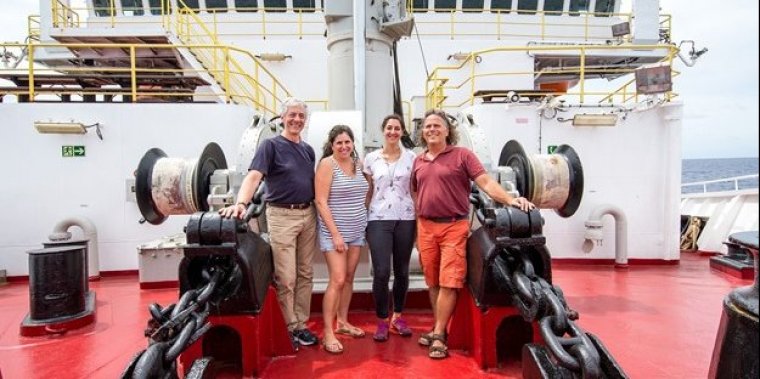| News / Science News |
Scientists solve climate change mystery
Scientists have resolved a key climate change mystery, showing that the annual global temperature today is the warmest of the past 10,000 years, according to a Rutgers University-led study.

Scientists aboard the drillship JOIDES Resolution: Gregory Mountain, Tali Babila, Samantha Bova and Yair Rosenthal. Photo: IODP-JRSO
The researchers say their findings challenge long-held views on the temperature history of the Holocene era, which began about 12,000 years ago.
"Our reconstruction shows that the first half of the Holocene was colder than in industrial times due to the cooling effects of remnant ice sheets from the previous glacial," said lead author Samantha Bova.
"The late Holocene warming was indeed caused by an increase in greenhouse gases, as predicted by climate models. That eliminates doubts about the key role of carbon dioxide in global warming."
The scientists used marine calcareous (calcium carbonate-containing) fossil foraminifera –- single-celled organisms that live at the ocean surface –- to reconstruct the temperature histories of the two most recent warm intervals on Earth.
They are the Last Interglacial period, from 115,000 to 128,000 years ago, and the Holocene.
To obtain the fossils, the scientists collected a core of bottom sediments near the mouth of the Sepik River off northern Papua New Guinea during Expedition 363 of the International Ocean Discovery Program. The sediments allowed the researchers to recreate the temperature history of the western Pacific warm pool, which closely tracks changes in global temperatures.
How temperature evolved during the Last Interglacial and Holocene eras is controversial. Some data suggest that the average annual global temperature during modern times does not exceed the warmth in the Holocene's early warm period, called the "Holocene thermal maximum," which was followed by global cooling.
But climate models strongly suggest that global temperatures have risen throughout the past 10,000 years.
The scientists found that post-industrial warming has indeed accelerated the long and steady trend of warming throughout that time period. (National Science Foundation)
YOU MAY ALSO LIKE





